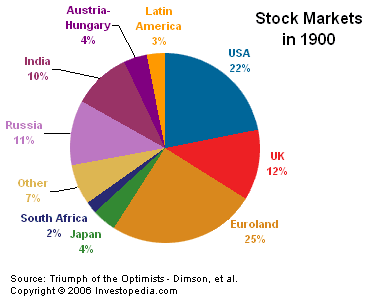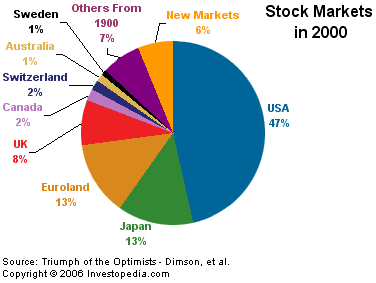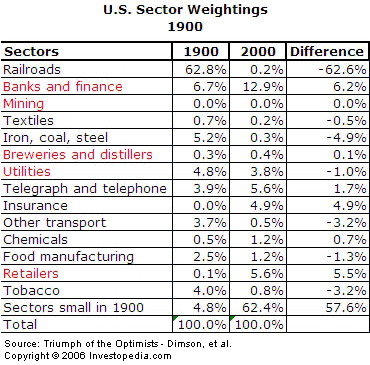History offers fascinating lessons - the twentieth century was no exception. In the book "Triumph Of The Optimists: 101 Years Of Global Investment Returns" (2002), Elroy Dimson, Paul Marsh and Mike Staunton offer the most complete study of historical global market returns. The book documents market returns for 16 countries from 1900 to 2000. From this research, it is evident that three important changes took place in the global stock market in the last century: the U.S. achieved market dominance; the exchanges were consolidated; and secular sector rotation occurred. Unfortunately, understanding the past doesn't necessarily make predicting the markets' future any easier. Read on to learn what happened in the past century and why some experts say history may not be destined to repeat itself.
To the Winner Go the Spoils
Unfortunately, until "Triumph Of The Optimists" was published, most of the available historical stock market data for the years prior to 1970 was only for the U.S. market. This isn't surprising, since the U.S. stock market was the big winner of the twentieth century. Its weighting increased to 47% of the world's total and, in general, it performed more favorably than the rest of the world's markets. This occurred for a number of reasons, but chief among them were larger investments in physical and human capital, greater technological advancement and greater productivity growth. With its huge investment demand and technological superiority, the U.S. investment industry was a worldwide leader. (To learn more, see What Are Economies Of Scale?.)
By contrast, other countries have lesser-known histories. For example, it took the U.K. much longer to recover from the world wars. Its diminished role after the collapse of the British Empire and the complicated bureaucracies of the colonial system slowed the U.K.'s growth immeasurably. According to the authors, problems with defense spending, labor, productivity and investment plagued the British economy and markets until the mid 1970s.
The U.S., on the other hand, suffered relatively little disruption to its stock market during the world wars and didn't have the prolonged declines that many of the European and Asian markets experienced. In fact, the United States' economy largely benefited from the wars - successful companies such as General Motors and IBM thrived as a result. At the same time, many other economies suffered great losses. For example, according to Phillipe Jorion and William N. Goetzmann in their article "Global Stock Markets In The Twentieth Century" (1999), the Japanese stock market saw a 95% decline in real returns between 1944 and 1949! The German market also suffered devastating losses. In this context, the U.S. market's success seems to be an exception, which the previous lack of data for other countries may have obscured.
Past Success and Future Performance
Many valuable lessons can be learned from history, but extrapolating historical returns into the future is difficult and complicated. For instance, few investors in 1900 could have predicted the monumental changes that would take place in the world after 1913. The two world wars, socialist revolutions, the Great Depression and the Bretton Woods Agreement all had a profound impact on the global economy and stock markets until the 1970s. The impact of these events suggests that although we can study the past, the social and economic events that might affect the markets in the future are often unpredictable. (For more insight, see Dollarization Explained and What Is the International Monetary Fund?)
Furthermore, despite the clear success of the U.S. markets since 1900, investors need to remember that this exceptional performance may be just that: the exception, rather than the rule for the twentieth century. "Triumph Of The Optimists" argues that economic and stock market performance in the U.S. has not been typical of other countries and, therefore, should not necessarily be extrapolated into the future.
The graphs below show a breakdown of the world markets in both 1900 and 2000 and the anomalous growth of the U.S. market during this time.
 |
 |
Globalization and Consolidation
The stock markets of 1900 had more regional exchanges than those of today. For example, Dimson, Marsh and Staunton state that the U.S. and U.K. each had 20 to 30 different regional exchanges. Most of these exchanges - such as the Los Angeles Exchange, which dealt with the petroleum industry - focused on the industries prevalent in their areas.
The difference between the number of exchanges in the early-twentieth century and the number that exists today is due mostly to advancements in telecommunications and innovation within financial markets. In "Globalization Myths" (1996), Paul Bairoch and Richard Kozul-Wright describe how, between 1930 and 1990, the cost of a three-minute telephone call from New York to London dropped from $245 to $3. Advancements like these have propelled the globalization of our economy and its financial markets. Today, New York, London and Tokyo are widely regarded as the world's financial centers, and technological advances have allowed them to be interconnected despite the distance between them. As a result, the twenty-first century global economy is defined by financial centers rather than smaller regional exchanges. (To read more, check out Getting To Know Stock Exchanges and The Tale Of Two Exchanges: NYSE And Nasdaq.)
Sector Rotation Like You Have Never Seen Before
Many investors today focus on short-term sector rotation to add value to their portfolios. According to Dimson, Marsh and Staunton's research, this type of rotation pales in comparison to the changes that can take place over the long term. Sector analysis of the U.S. market between 1900 and 2000 shows us an interesting picture.
 |
 |
Just as a country's influence over global economics evolves, so do the sectors of an economy. As these two tables show, the economies of 1900 and 2000 had few similarities. Of particular note are the sectors that were small in 1900 and 2000. For instance, 84% of the sectors today (represented by market capitalization) were of immaterial size or were non-existent at the beginning of the last century. These sweeping changes also make extrapolating future market performance from past events difficult. (Check out Sector Rotation: The Essentials and The Stages Of Industry Growth.)
Clearly, technological advancements have a big impact on the stock market. Just as railroads consumed the investing public in the latter part of the nineteenth century, computers and the internet did the same at the end of the twentieth century. For all we know, the dominant sector at the end of the twenty-first century may not even exist today. Which technologies will have the most profound impact on the world's productivity in the future? In order to successfully invest in these technologies, you will need to predict these changes before they affect the market - a task that is much easier said than done.
Conclusion
Can the U.S. continue its dominance for another century? Change is inevitable, but one thing is certain: the stock markets of 2100 will look very different than those of today. The incredible advancements in telecommunications have left their mark on the world stock markets, and major centers like New York, London and Tokyo now dominate a once fragmented marketplace. It is easy to refer to the past, but when it comes to your own finances, make sure that your portfolio is structured for the future - in light of all the changes that the markets have undergone so far, basing it on what has occurred in the past may not make sense.
